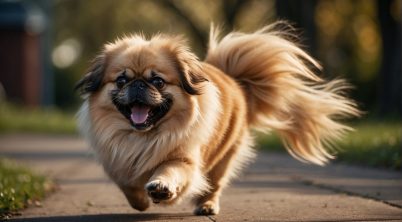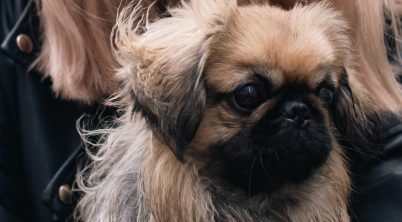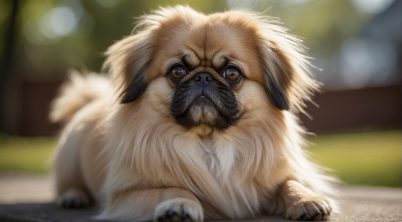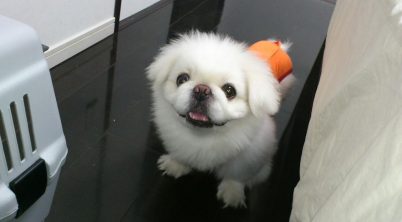Uncovering the Breed’s Positive Attributes
The Pekingese, an ancient breed hailing from China, is steeped in regal history and carries itself with a confident demeanor that belies its small size. Originally bred as companions to Chinese nobility, these dogs have long been associated with luxury and a noble bearing. Despite their plush appearance, they are known for their courage, boldness, and self-esteem. Beyond their ornamental function in palaces, they have emerged as independent and sometimes stubborn companions, embodying a unique blend of dignity and tenacity.
While not necessarily designed for physically demanding activities, Pekingese have a distinct personality that makes them suitable for a variety of living situations. Their physical features, such as a luxurious long coat with profuse feathering, create a distinctive look associated with prestige and understated elegance. This breed’s unwavering loyalty and affectionate nature towards their human counterparts make them a cherished pet in the households they grace.
As with many pedigrees, the Pekingese comes with its own set of considerations for potential owners. Their care regimen requires attention to grooming, owing to their coat, and vigilance towards their health. With eyes that claim both vulnerability and charm, and a predisposition for calm observation over boisterous play, the Pekingese presents itself as a breed well-suited to those looking for a dignified yet loving companion.
Good things about Pekingese
The Pekingese breed boasts a rich history intertwined with Chinese royalty, which has shaped many of their admirable qualities. They are known for their loyalty and tend to form strong bonds with their human companions. This breed’s affectionate nature makes them excellent companions, particularly for those seeking a close relationship with their pet.
One of the Pekingese’s notable traits is their intelligence. They have the capacity to learn various tricks and respond to training, though they often exhibit an independent streak that requires a patient and consistent approach. Their intelligence, combined with their self-assured attitude, can be delightful for owners who appreciate an animal with a distinct personality.
Despite their petite size, Pekingese are spirited and courageous. They carry themselves with a dignified poise and possess an alert nature. While their small stature doesn’t make them effective guard dogs in terms of physicality, their boldness and vigilance often lead them to alert their family of unusual activities or sounds.
Here is a summary of their positive attributes:
| Quality | Benefit |
|---|---|
| Loyalty | Forms strong, loving bonds with owners. |
| Affection | Provides warm companionship, enhancing the bond. |
| Intelligence | Capable of learning and engaging in interactive play. |
| Courage | Demonstrates a brave heart, often protective of their home. |
In essence, the Pekingese carries a blend of charm and bravery that makes them not just a pet but a loyal member of the family. Their company is especially cherished by those who value a pet with a distinctive character and loving demeanor.
Breed Characteristics
The Pekingese, often referred to as “lion dogs,” hold a storied place among toy breeds, admired for their regal and dignified demeanor. This breed exhibits a calm and alert presence that mirrors their esteemed history, which notably includes being favored by Queen Victoria.
Physical Attributes:
- Size: Small and compact, the Pekingese is classified as a toy breed.
- Weight: Typically not exceeding 14 pounds.
- Coat: Characterized by a long, thick coat that requires regular grooming.
Coat Colors:
- Common colors include sable, red, black, white, cream, and tan.
Temperament:
- Calm: Pekingese typically carry a serene and composed nature.
- Affectionate: They form strong bonds and display loyalty to their owners.
- Independent: This breed’s strong-willed personality is paired with an independent streak.
- Willful: The Pekingese can exhibit a willful temperament, which combined with their independence can sometimes present training challenges.
Overall Demeanor: They tend to be somewhat aloof, particularly with strangers, adding to their aristocratic aura. The Pekingese temperament is a complex blend of affectionate loyalty towards their family members and a reserved confidence when dealing with unfamiliar situations or people. This breed’s confident gait and self-assured attitude encapsulate the spirit of what many enthusiasts consider a canine epitome of self-esteem and courage.
Health and Care
Health Problems: Pekingeses are brachycephalic, meaning they have flat faces and shortened nasal passages which can lead to breathing difficulties. This breed may also be prone to eye diseases due to their prominent eyes; care should be taken to keep their eyes clean and free from debris. Additionally, Pekingeses might experience joint diseases such as patellar luxation, and they can suffer from itchy skin conditions that require veterinary attention.
Grooming: Pekingeses are known for heavy shedding; therefore, regular grooming is vital. Brushing a few times a week, with a deep grooming session every month, can help manage shedding and maintain coat health. Their coat requires trimming to prevent matting and overgrowth, particularly around the eyes and feet for better visibility and mobility.
| Maintenance Activity | Frequency |
|---|---|
| Brushing | Several times a week |
| Professional Grooming | Every 6-8 weeks |
| Eye Cleaning | Daily |
| Trimming (eyes/feet) | As needed |
Exercise Requirements: Despite their small size, Pekingeses need regular exercise to maintain physical health and prevent obesity, which can exacerbate joint issues and breathing problems. A regimen of daily exercise, like short walks or indoor play, is recommended. However, their physical activity must be moderate due to their respiratory limitations.
Food and Diet: A balanced diet is essential for the Pekingese, taking into account their propensity for weight gain. They often do well on high-quality food formulated for small breeds with appropriate nutrient ratios to promote overall health and support their energy needs. It’s critical to monitor the amount of food intake to prevent obesity, considering their exercise needs.
Behavior and Training
The Pekingese dog breed is known for its loyal nature and intelligent mindset, making it a beloved companion. However, they can also display stubbornness, which may pose challenges during training. To effectively train a Pekingese, a regimen of formal training and early socialization is paramount. Positive reinforcement techniques work best, as they tend to respond more to encouragement rather than punishment.
Consistency is key when establishing obedience in a Pekingese since their stubborn streak often requires more repetition and patience than some other breeds. A Pekingese may be wary of strangers and can appear aloof with strangers. Without proper socialization, this trait can turn into aggression.
- Effective Training Approaches:
- Always use positive reinforcement.
- Maintain a consistent routine to instill obedience.
- Start socialization early to temper their independence and wariness.
Interaction with family and children should be monitored, especially if the Pekingese hasn’t been properly socialized. Due to their size and temperament, they are best in homes with older children who understand how to interact with dogs. Families should introduce their Pekingese to a variety of people and settings from a young age to develop a well-rounded personality.
Training a Pekingese can certainly be a test of patience, but with consistent, positive methods, they can become well-mannered and affectionate members of any family. A well-socialized Pekingese is typically more accepting of strangers and adapts well to various social situations.
Living with a Pekingese
Living with a Pekingese offers a unique blend of regal dignity and affectionate companionship. These dogs are known for their confidence and independence, embodied in their sturdy and chunky build. Despite their compact size, they carry themselves with a poise that demands respect.
The Pekingese, originally bred as a lap dog for Chinese royalty, has evolved into an admirable family pet. They are well-mannered and can fit seamlessly into a home environment, often becoming true companions. Their affectionate nature makes them excellent lap dogs, always eager for a gentle stroke or a warm lap.
As watchdogs, Pekingese are alert and vocal. Their stark awareness of their surroundings makes them reliable for notifying their family of strangers approaching, although they are polite once properly introduced. Being watchful, they can serve as decent, albeit small, protectors of their home.
Yet, it’s essential to understand their limits. Due to their compact nature, they don’t require extensive exercise, which makes them suited for senior citizens or those with a more sedate lifestyle. Light play and daily walks suffice to keep them healthy and content, you can also take your dog kayaking.
For families, Pekingese can be a joy, but they do best with gentle handling. Their independent streak means they respond well to firm but kind training. Affection and socialization from an early age mold them into well-rounded pets.
Lastly, while they are known as “sleeve dogs”, implying they can be carried around like a fashion accessory, they maintain a dignified air and shouldn’t be relegated to simply a novelty. They thrive when treated as part of the family unit, with the same respect afforded to every member.
In summary, the Pekingese can make a loyal and noble addition to any household, whether as a lapdog for quiet companionship or as a watchdog with a surprisingly authoritative bark.
| Traits | Pekingese Attribute |
|---|---|
| Size | Compact and sturdy |
| Personality | Dignified, confident, independent |
| Exercise Needs | Low; suitable for apartment living |
| Family Life | Loyal and affectionate |
| Watchdog | Alert; good for notifying of strangers |
* Banner by Sharon Sipple, cropped | Some rights reserved








